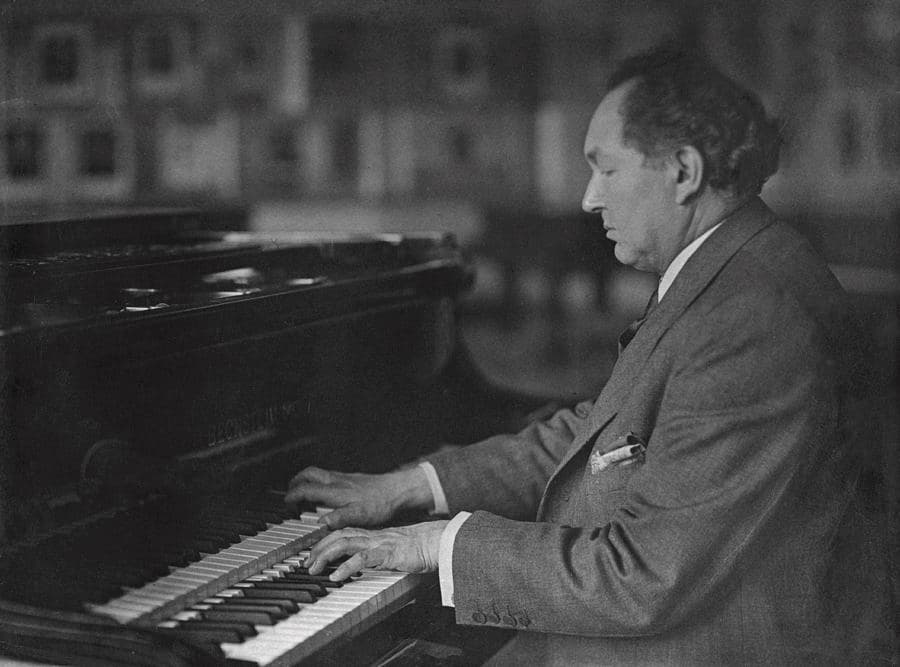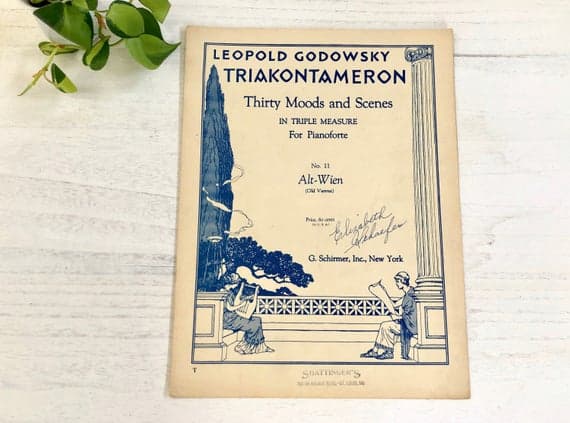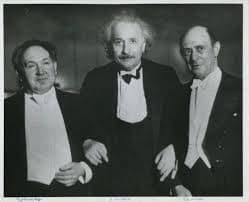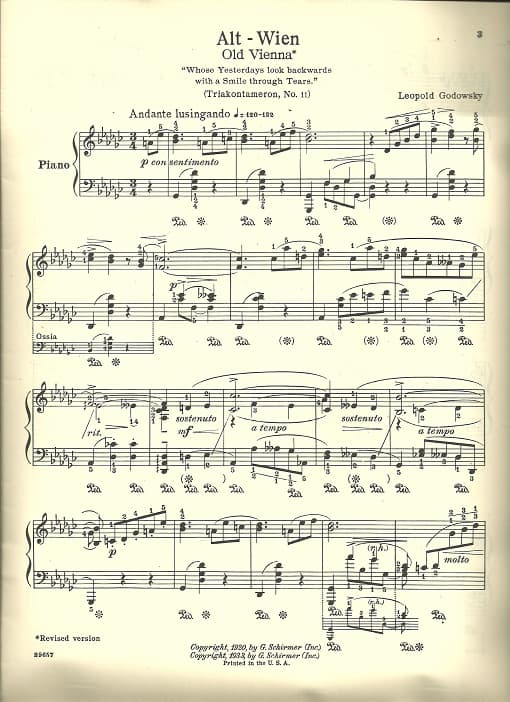Working in the 14th century, the Italian author Giovanni Boccaccio (1313–1375) compiled a collection of novellas entitled Decameron, sometimes nicknamed the “Human Comedy.” The work is set in Italy during the time of the Black Death, when a group of seven young women and three young men flee from Florence to a deserted villa in the countryside for a two-week quarantine. To pass the time, each member of the party tells a story each night, except for one day per week reserved for chores and the holy days when they don’t work at all. At the end of the fortnight, with ten nights of storytelling, they have told 100 stories, and hence the title. Young people and all, of course tell each other love stories, which range from the erotic to the tragic. The pianist and composer Leopold Godowsky decided to compile a work entitled Trikontameron. Inspired by Boccaccio’s collection, Godowsky decided to compose thirty piano pieces in thirty days.
Leopold Godowsky: Trikontameron – No. 1 Nocturnal Tangier (Konstantin Scherbakov, piano)
Leopold Godowsky: Trikontameron – No. 4 Rendez-vous (Konstantin Scherbakov, piano)

Leopold Godowsky
Heralded as the “Buddha of the Piano” among musical giants, Polish-American pianist and composer Leopold Godowsky (1870-1938) once wrote, “I love the piano and those who love the piano. The piano, as a medium for expression, is a whole world by itself. No other instrument can fill or replace its own say in the world of emotion, sentiment, poetry, imagery, and fancy.” Godowsky composed the majority of his Trikontameron while staying in Seattle. In fact, it took him slightly longer to finish the suite because of concert engagements in Los Angeles, Chicago, and New York. The suite is subtitled “Thirty Moods and Scenes in Triple Measure,” and it was completed in 1920 and published by Schirmer in six volumes, each containing five pieces.
Leopold Godowsky: Trikontameron – No. 6 The Pleading Troubadour (Konstantin Scherbakov, piano)
Leopold Godowsky: Trikontameron – No. 7 Yesteryear… (Konstantin Scherbakov, piano)

Trikontameron music score cover
The picturesquely entitled miniatures in Trikontameron are inspired by a variety of moods, places, and experiences. What holds the whole set together, however, is the marvelous subtlety of the waltz, as all pieces are written in three-quarter-time. Exotic melodies infuse “Nocturnal Tangiers,” and “Sylvan Tyrol” offers a mountain dance from the alpine region of Austria. Referencing Schumann’s Florestan and Eusebius, “Paradoxical Moods” vacillates between the forceful and meditative, while “Rendez-Vous” sounds like a highly seductive waltz. To end the first volume, Godowsky presents us with some gentle ghostly figures in “Twilight Phantasms.”
Leopold Godowsky: Trikontameron – No. 11 Alt-Wien, ‘Whose yesterdays look backwards with a smile through tears’ (Konstantin Scherbakov, piano)
Leopold Godowsky: Trikontameron – No. 15 The Temptress (Konstantin Scherbakov, piano)
The lively and light-hearted “Watteau Paysage” contrasts the plaintive “Pleading Troubadour” and melancholy “Yesteryear.” We are chromatically led into “The Enchanted Glen,” and “Resignation” sounds a doleful melody in the lower register.
Leopold Godowsky: Trikontameron – No. 17 An American Idyll (Konstantin Scherbakov, piano)
Leopold Godowsky: Trikontameron – No. 20 Whirling Dervishes (Konstantin Scherbakov, piano)

Godowsky, einstein and Schoenberg
The undoubtedly best-known piece in Trikontameron is “Alt-Wien.” This is a haunting evocation of the vanished city of Lanner and the Strauss families, and Godowsky even appends the subtitle “Whose Yesterdays look backwards with a Smile through Tears.” That piece achieved great popularity in an arrangement for violin and piano by Jascha Heifetz. “Ethiopian Serenade” turns to the superficially exotic, and “Terpsichorean Vindobona”—the name given to Vienna by the old Romans—is a jaunty little dance. “Whitecaps” is extremely virtuosic, and “The Temptress” offers a seductive contrast.
Leopold Godowsky: Trikontameron – No. 21 The Salon (Konstantin Scherbakov, piano)
Leopold Godowsky: Trikontameron – No. 22 An Epic (Konstantin Scherbakov, piano)

Leopold Godowsky: Trikontameron Vol III
The fourth volume contains a dramatic story in “Old Ballade,” and the tender “An American Idyll.” Popular melodies in a chromatic context appear in “Anachronism,” and “A Little Tango Rag” is predictably upbeat. Godowsky probably first hand saw “Whirling Dervishes” during his travels in the Near East. In the fifth volume, we find the elegant “Salon,” which is contrasted in mood and bravura by “An Epic.” The “Music-Box” imitates the tinkling resonance and texture, and “Lullaby” offers some peace and tranquility. It all ends, as it always does, with “Memories.”
Leopold Godowsky: Trikontameron – No. 27 Lament (Konstantin Scherbakov, piano)
Leopold Godowsky: Trikontameron – No. 30 Requiem – Epilogue (Konstantin Scherbakov, piano)
At the beginning of the sixth and final volume, we are treated to “The Cuckoo-Clock” with melancholy making a return appearance in the “Lament.” There is a possible reference to Don Quixote in the “Quixotic Errantry,” while the “Poeme Macabre” becomes a sinister dance. The suite ends with a solemn “Requiem,” which unexpectedly proceeds to an “Epilogue” featuring an elaborate version of “The Star-Spangled Banner.” A New York Times obituary tellingly wrote, “Leopold Godowsky sought new musical worlds to conquer,” and that is exactly what the Trikontameron is all about.
For more of the best in classical music, sign up for our E-Newsletter
